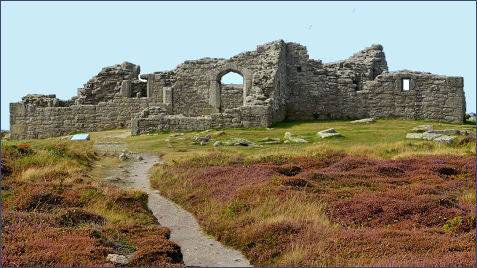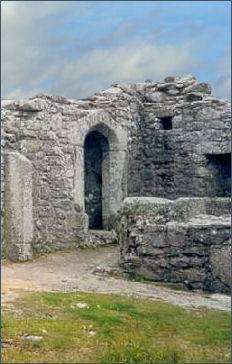King Charles Castle
OS grid reference :- SV 897154
 The ruined artillery fort of King Charles's Castle is situated on the highest point on the west side of Castle Down, overlooking New Grimsby harbour on the island of Tresco.
The ruined artillery fort of King Charles's Castle is situated on the highest point on the west side of Castle Down, overlooking New Grimsby harbour on the island of Tresco.
The fort was constructed between 1548 and 1551 to guard the narrow strait which leads past New Grimsby harbour and on towards St Mary's from French attack, it once contained a battery of guns and an accompanying garrison, designed to prevent enemy vessels from entering the harbour.
The granite castle is cruciform in shape, it was originally two storeys high. It is entered on the eastern side by a guardroom, with the gun battery at the front, and a dining room, kitchen and living accommodation at the back. An arched doorway, which still retains its drawbar slot, leads into a large rectangular hall which has two fireplaces, one of which contains a bread oven. Two small chambers at either end were probably designed as sleeping quarters. The castle's design is unusual for the period, and is only seen elsewhere in blockhouses along the River Thames.
 During the seventeenth century an additional defensive earthwork was built around it.
The castle's proved unsatisfactory, as its guns could not be positioned to fire down into the harbour, and its defences were considered vulnerable to attack.
During the seventeenth century an additional defensive earthwork was built around it.
The castle's proved unsatisfactory, as its guns could not be positioned to fire down into the harbour, and its defences were considered vulnerable to attack.
An additional blockhouse was constructed below, closer to the waters edge, but eventually a new fort, known as Star Castle, was built instead on the neighbouring island of St Mary's, which became the main fort in the Scilly Isles.
In the aftermath of the Civil War, the Scilly Isles were held by the Royalist sympathisers of King Charles I, who gave the castle its current name. The islands were attacked by a Parliamentary force led by Sir Robert Blake in 1651, who landed on Tresco but bypassed the fort as he took the island. Its Royalist defenders blew up parts of the castle as they left, and some of its stone appears to have been used to build the newer Cromwell's Castle by the harbour.
Although King Charles's Castle was being used to house soldiers in 1660, by the eighteenth century it was described as ruinous. The castle was originally two storeys high but the walls now only rise up to 3.4 metres in height. The much-eroded remains of further outworks can be traced eastwards across Castle Down, where a large bastion of uncertain date is set amid prehistoric cairns and field systems.
After 1922, the castle passed into the ownership of the Ministry of Works, and archaeological excavations were carried out in 1954 which uncovered pottery, a sixteenth or seventeenth century bronze buckle and two coins of Henry VIII and Edward VI. The site is now in the care of English Heritage and is open to visitors.